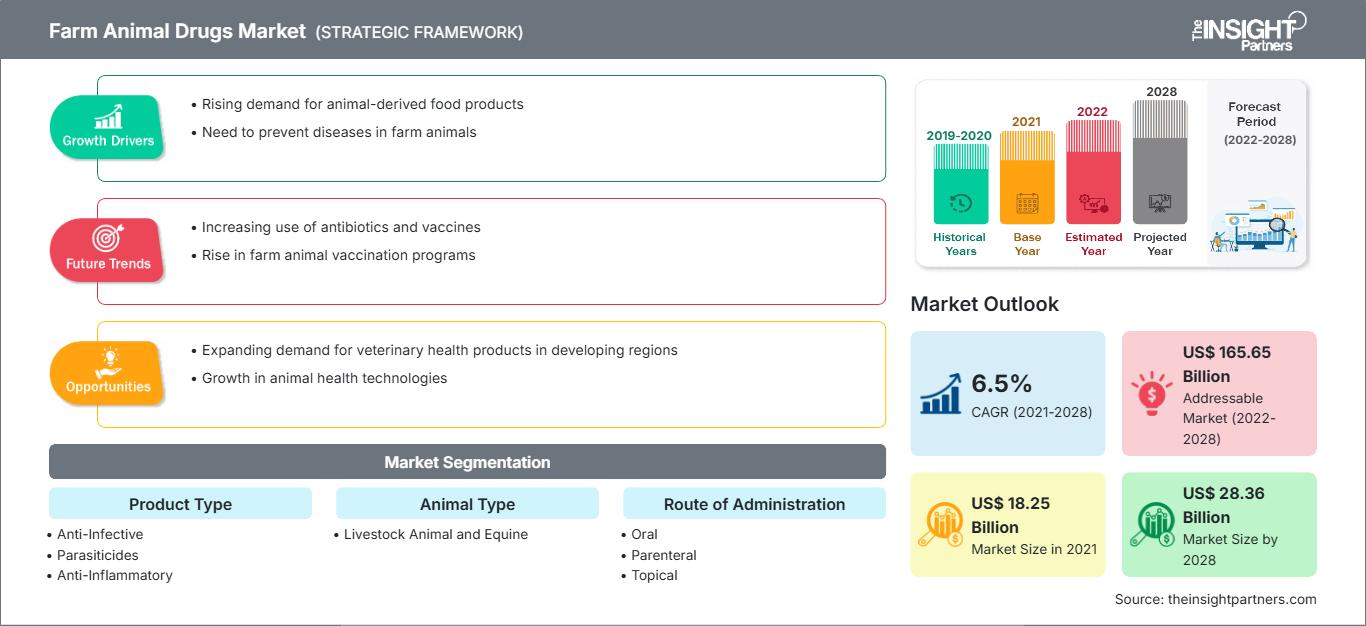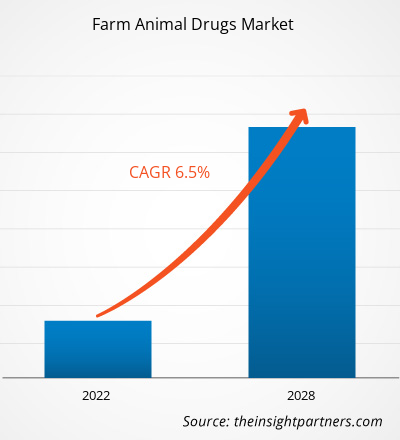Der Markt für Arzneimittel für Nutztiere soll von 18.253,09 Millionen US-Dollar im Jahr 2021 auf 28.364,08 Millionen US-Dollar im Jahr 2028 wachsen; von 2021 bis 2028 wird mit einer durchschnittlichen jährlichen Wachstumsrate von 6,5 % gerechnet.
Arzneimittel spielen eine Schlüsselrolle bei der Erhaltung der Gesundheit von Nutztieren und der Verbesserung der wirtschaftlichen Lage der landwirtschaftlichen Erzeuger. Der Bedarf an besserer Produktivität ist wichtiger geworden, da die Bevölkerung nach nahrhaften und krankheitsfreien Lebensmitteln sucht. Die pharmakologisch aktiven Verbindungen helfen, die Übertragung von Krankheiten von Tieren auf Menschen zu verhindern. Die Gesundheit von Nutztieren wurde maßgeblich durch den Einsatz von Arzneimitteln beeinflusst. Arzneimittel für Nutztiere sind Medikamente, die in der Gesundheitsfürsorge zur Diagnose, Heilung, Linderung, Behandlung oder Vorbeugung von Krankheiten eingesetzt werden, die Nutztiere befallen könnten. Diese Medikamente werden gemäß strengen Anforderungen eingesetzt, die auf ihrer Notwendigkeit für die Erhaltung des Wohlbefindens von Nutztieren basieren. Kurz gesagt: Tierarzneimittel sind ein Schlüsselfaktor für das Wachstum der Viehwirtschaft weltweit. Faktoren wie der zunehmende Einsatz von Schmerzmitteln bei Nutztieren, die steigende Zahl lebensmittelbedingter Krankheiten und Infektionen sowie die steigende Nachfrage nach hochwertigen Arzneimitteln und Lebensmittelsicherheit fördern das Wachstum des Marktes für Tierarzneimittel. Allerdings hemmen die Nebenwirkungen von Medikamenten bei Tieren und strenge staatliche Vorschriften für die Verwendung von Tierarzneimitteln das Marktwachstum.
Passen Sie diesen Bericht Ihren Anforderungen an
Sie erhalten kostenlos Anpassungen an jedem Bericht, einschließlich Teilen dieses Berichts oder einer Analyse auf Länderebene, eines Excel-Datenpakets sowie tolle Angebote und Rabatte für Start-ups und Universitäten.
Markt für Nutztiermedikamente: Strategische Einblicke

-
Holen Sie sich die wichtigsten Markttrends aus diesem Bericht.Dieses KOSTENLOSE Beispiel umfasst Datenanalysen, die von Markttrends bis hin zu Schätzungen und Prognosen reichen.
Markteinblicke
Zunehmender Einsatz von Schmerzmitteln bei Nutztieren fördert das Wachstum des Marktes für Arzneimittel für Nutztiere
Schmerzen bei Nutztieren werden oft mit häufigen Produktionskrankheiten wie Lahmheit und Mastitis in Verbindung gebracht und den Tieren durch routinemäßige Haltungspraktiken wie Kastration und Schwanzkupieren zugefügt. Schmerzen verursachen Verhaltensänderungen, autonome und neuroendokrine Veränderungen, führen zu negativen affektiven Zuständen, beeinträchtigen das Tierwohl und schaden der Rentabilität der Landwirtschaft.
Die Kontrolle von Schmerzen ist für die Gesundheit aller Tiere unerlässlich. Im Jahr 2018 hat die Food and Drug Administration (FDA) das erste Schmerzmittel zur Verwendung bei Nutztieren zugelassen. Moderhinke ist eine häufige Ursache für Schmerzen und Lahmheit bei Rindern aller Altersgruppen und Rassen. Die Krankheit tritt bei Rindern auf, die in Ställen und auf Weiden gehalten werden, sowie bei Rindern auf der Weide. Banamine Transdermal ist zur Behandlung von Schmerzen im Zusammenhang mit Moderhinke bei Rindern zugelassen und nur auf ärztliche Verschreibung erhältlich. Das FDA Center for Veterinary Medicine fördert und schützt die Tiergesundheit, indem es die Verfügbarkeit sicherer und wirksamer Medikamente für Tiere gewährleistet. Die Zusammenarbeit mit Pharmaunternehmen bei der Entwicklung und Zulassung von Medikamenten zur Schmerzkontrolle bei allen Tieren, einschließlich Nutztieren, ist ein integraler Bestandteil dieser Mission.
In der Tierhaltung gibt es mehrere Routinepraktiken, die eine effiziente Schmerzbehandlung bei Tieren erfordern. Einige Routineverfahren, die bei Nutztieren Schmerzen verursachen, sind Kastration, Enthornung oder das Entfernen der Knospen und das Brandmarken. Zu den am häufigsten verwendeten Medikamenten zur Schmerzkontrolle bei Nutztieren gehören nichtsteroidale Antirheumatika (NSAR), Lokalanästhetika, α2-Agonisten und Opioide. Die effiziente Schmerzbehandlung bei Nutztieren ist weltweit zunehmend zu einem Anliegen der Verbraucher geworden, was zu großem Interesse der Regulierungsbehörden geführt hat. Folglich entwickelt sich die Tierhaltungsindustrie weltweit weiter und verwendet neue Praktiken und Off-Label-Analgetika, wobei Tierschutz und Rentabilität stets im Vordergrund stehen. Dies hat zu einem erheblichen Anstieg des Einsatzes von Schmerzmitteln wie Lidocain, Xylazin, Detomidin, Medetomidin, Ketamin, Tolfenaminsäure, Buprenephrin usw. in der allgemeinen Schmerzbehandlung von Nutztieren geführt.
Die Verbraucher sind sich des Wohlergehens von Tieren, die zur Lebensmittelgewinnung gezüchtet werden, zunehmend bewusst und besorgt. Dadurch werden die Lieferanten unter Druck gesetzt, eine humane Behandlung der in ihre Systeme gelangenden Tiere zu gewährleisten. Es werden Maßnahmen ergriffen, um dieser Nachfrage gerecht zu werden. In den USA ist nur ein Medikament zur Kontrolle von Schmerzen durch Interdigitalphlegmone (Klauenfäule) bei nicht laktierenden Rindern zugelassen. Daher wird die Verwendung von Medikamenten zur Schmerzbehandlung bei geplanten Eingriffen wie Enthornung und Kastration bei Rindern oder zur Schmerzlinderung bei laktierenden Milchkühen und Schweinen als nicht bestimmungsgemäße Verwendung von Arzneimitteln betrachtet. Sie wird gemäß der Klarstellung zum Gesetz über die Verwendung von Tierarzneimitteln geregelt. Flunixin, Meloxicam und Ketoprofen sind nichtsteroidale Antirheumatika, deren Wirksamkeit zur Schmerzlinderung in landwirtschaftlichen Betrieben durch Forschung unterstützt wird. Verschiedene Produkte zur Schmerzlinderung bei Tieren, wie Lokal- und Regionalanästhetika, Opioide und nichtsteroidale Antirheumatika (NSAR), sind auf dem Markt erhältlich.
Produkttypbasierte Erkenntnisse
Basierend auf dem Produkttyp ist der Markt für Nutztiermedikamente in Antiinfektiva, Parasitizide, Entzündungshemmer, Anästhetika, Analgetika, Hormone und verwandte Produkte und Sonstiges unterteilt. Das Segment Parasitizide hatte 2021 den größten Marktanteil und wird im Prognosezeitraum voraussichtlich die höchste durchschnittliche jährliche Wachstumsrate verzeichnen.
Tiertypbasierte Erkenntnisse
Basierend auf dem Tiertyp ist der Markt für Nutztiermedikamente in Nutztiere und Pferde unterteilt. Das Segment Nutztiere hatte im Jahr 2021 mit 90,77 % den größten Marktanteil und wird seine beherrschende Stellung im Prognosezeitraum voraussichtlich beibehalten.
Erkenntnisse zum Verabreichungsweg
Basierend auf dem Verabreichungsweg ist der Markt für Arzneimittel für Nutztiere in orale, parenterale, topische und sonstige Verabreichung unterteilt. Das orale Segment hatte im Jahr 2021 mit 90,77 % den größten Marktanteil und wird seine beherrschende Stellung im Prognosezeitraum voraussichtlich beibehalten.
Erkenntnisse zum Vertriebskanal
Basierend auf dem Vertriebskanal ist der Markt für Arzneimittel für Nutztiere in Tierkliniken, Tierkliniken, Apotheken und Drogerien und sonstige unterteilt. Das Segment der Tierkliniken hatte im Jahr 2021 den größten Marktanteil, während für das Segment der Tierkliniken im Prognosezeitraum ein CAGR-Wachstum von 6,9 % erwartet wird.
Verschiedene auf dem Markt für Arzneimittel für Nutztiere tätige Unternehmen verfolgen Strategien wie Produkteinführungen, Fusionen und Übernahmen, Kooperationen, Produktinnovationen und die Erweiterung ihres Produktportfolios, um ihre Präsenz weltweit auszubauen, ihren Markennamen zu wahren und die wachsende Nachfrage der Endverbraucher zu befriedigen.
Arzneimittel für Nutztiere
Regionale Einblicke in den Markt für Nutztiermedikamente
Die Analysten von The Insight Partners haben die regionalen Trends und Faktoren, die den Markt für Tierarzneimittel im Prognosezeitraum beeinflussen, ausführlich erläutert. In diesem Abschnitt werden auch die Marktsegmente und die geografische Lage in Nordamerika, Europa, dem asiatisch-pazifischen Raum, dem Nahen Osten und Afrika sowie Süd- und Mittelamerika erörtert.
Umfang des Marktberichts über Arzneimittel für Nutztiere
| Berichtsattribut | Einzelheiten |
|---|---|
| Marktgröße in 2021 | US$ 18.25 Billion |
| Marktgröße nach 2028 | US$ 28.36 Billion |
| Globale CAGR (2021 - 2028) | 6.5% |
| Historische Daten | 2019-2020 |
| Prognosezeitraum | 2022-2028 |
| Abgedeckte Segmente |
By Produkttyp
|
| Abgedeckte Regionen und Länder |
Nordamerika
|
| Marktführer und wichtige Unternehmensprofile |
|
Dichte der Marktteilnehmer für Arzneimittel für Nutztiere: Verständnis ihrer Auswirkungen auf die Geschäftsdynamik
Der Markt für Nutztiermedikamente wächst rasant. Die steigende Nachfrage der Endverbraucher ist auf Faktoren wie veränderte Verbraucherpräferenzen, technologische Fortschritte und ein stärkeres Bewusstsein für die Produktvorteile zurückzuführen. Mit der steigenden Nachfrage erweitern Unternehmen ihr Angebot, entwickeln Innovationen, um den Bedürfnissen der Verbraucher gerecht zu werden, und nutzen neue Trends, was das Marktwachstum weiter ankurbelt.

- Holen Sie sich die Markt für Nutztiermedikamente Übersicht der wichtigsten Akteure
Markt für Arzneimittel für Nutztiere – nach Produkttyp
- Antiinfektiva
- Parasitizide
- Entzündungshemmer
- Anästhetika
- Schmerzmittel
- Hormone und verwandte Produkte
- Sonstige
Markt für Arzneimittel für Nutztiere – nach Tierart
- Nutztiere
- Pferde
Markt für Arzneimittel für Nutztiere – nach Verabreichungsweg
- Oral
- Parenteral
- Topisch
- Sonstige
Markt für Arzneimittel für Nutztiere – nach Vertriebskanal
- Tierkliniken
- Tierkliniken
- Apotheken und Drogerien
- Sonstige
Markt für Arzneimittel für Nutztiere – nach Geografie
• Nordamerika
- USA
- Kanada
- Mexiko
• Europa
- Frankreich
- Deutschland
- Italien
- Großbritannien
- Spanien
- Restliches Europa
• Asien-Pazifik (APAC)
- China
- Indien
- Südkorea
- Japan
- Australien
- Restlicher Asien-Pazifik-Raum
• Naher Osten & Afrika (MEA)
- Südafrika
- Saudi-Arabien
- VAE
- Rest des Nahen Ostens und Afrikas
• Süd- und Mittelamerika (SCAM)
- Brasilien
- Argentinien
- Rest von Süd- und Mittelamerika
Firmenprofile
- PHIBRO ANIMAL HEALTH CORPORATION
- Zoetis Inc.
- Ceva
- Elanco
- Virbac
- INTAS PHARMACEUTICALS LTD.
- Alembic Pharmaceuticals Limited
- Boehringer Ingelheim International GmbH
- MSD Animal Health
- Vetoquinol SA
- Historische Analyse (2 Jahre), Basisjahr, Prognose (7 Jahre) mit CAGR
- PEST- und SWOT-Analyse
- Marktgröße Wert/Volumen – Global, Regional, Land
- Branchen- und Wettbewerbslandschaft
- Excel-Datensatz
Aktuelle Berichte
Verwandte Berichte
Erfahrungsberichte
Grund zum Kauf
- Fundierte Entscheidungsfindung
- Marktdynamik verstehen
- Wettbewerbsanalyse
- Kundeneinblicke
- Marktprognosen
- Risikominimierung
- Strategische Planung
- Investitionsbegründung
- Identifizierung neuer Märkte
- Verbesserung von Marketingstrategien
- Steigerung der Betriebseffizienz
- Anpassung an regulatorische Trends






















 Kostenlose Probe anfordern für - Markt für Nutztiermedikamente
Kostenlose Probe anfordern für - Markt für Nutztiermedikamente